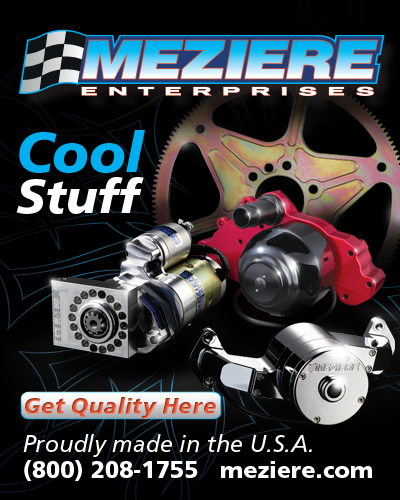ENCORE: BUDDY INGERSOLL: THE DAY MODERN TECHNOLOGY SCARED PRO STOCK
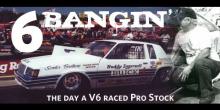 Sometimes the best laid plans on paper just don’t jibe with politics.
Sometimes the best laid plans on paper just don’t jibe with politics.
Buddy Ingersoll of Ziegler, Ill., knows that to be an accurate statement.
A little over 22-years ago, with the blessings of the IHRA’s tech department, Ingersoll began entering Pro Stock events with his twin turbocharged, 260-inch Buick Regal. This was fine until he leaned on the locals and started running quick in qualifying and even worse, started winning rounds.
Ingersoll reached the final round of the 1986 IHRA Fall Nationals in Bristol, Tenn., and afterwards found himself banished back to NHRA’s Competition eliminator. If it hadn’t been for a burned up clutch in the final round against Pro Stock icon Bob Glidden, he might have been tarred and feathered in the pits.
Originally published in 2001.
Buddy Ingersoll passed away on Sunday, March 11, 2012. We've republished this article in tribute to a friend and hero.
***********
On a September day in 1986, Pro Stock saw a glimpse of the future -- a future that will likely never happen ...
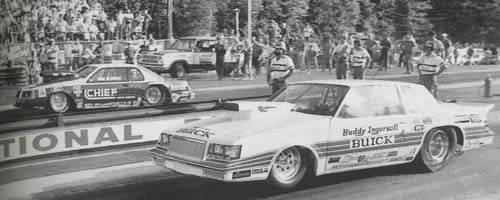
Sometimes the best laid plans on paper just don’t jibe with politics.
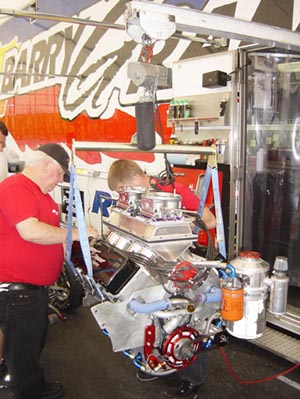
Buddy Ingersoll of Ziegler, Ill., knows that to be an accurate statement.
A little over 22-years ago, with the blessings of the IHRA’s tech department, Ingersoll began entering Pro Stock events with his twin turbocharged, 260-inch Buick Regal. This was fine until he leaned on the locals and started running quick in qualifying and even worse, started winning rounds.
Ingersoll reached the final round of the 1986 IHRA Fall Nationals in Bristol, Tenn., and afterwards found himself banished back to NHRA’s Competition eliminator. If it hadn’t been for a burned up clutch in the final round against Pro Stock icon Bob Glidden, he might have been tarred and feathered in the pits.
If Glidden would have lost, he’d have been lynched by his peers.
For Ingersoll, the IHRA was his last chance to race his turbo V-6 car as a professional entry and knowing such, he threw out all of the stops at the risk of losing the only chance he had to race at that level.
Those who know Ingersoll dating back to his championship days in Modified eliminator knew he’d make the most of his opportunity. A rumor surfaced that Ingersoll lifted in the finals against Glidden to appease his adversaries.
No chance in Hades, Ingersoll points out.
“I’ve raced all of my life trying to beat people as bad as I could beat them,” Ingersoll said. “Rickie Smith told everyone I lifted against Glidden but I didn’t. I would have run him wide open all the way even if we would have raced to the ocean. I’m not like that. I get enjoyment out of beating people.”
Ingersoll had every right to lay his all on the table against Glidden considering all he’d been subjected to in the year leading up to the Bristol outing.
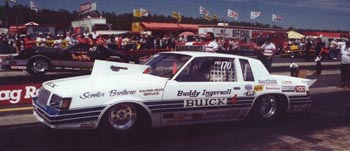 The concept initially was proposed to the NHRA, who reportedly had Ingersoll and his factory-backers jump through hoop after hoop, only to squelch their efforts in the end.
The concept initially was proposed to the NHRA, who reportedly had Ingersoll and his factory-backers jump through hoop after hoop, only to squelch their efforts in the end.
"The people at Buick talked to NHRA about running a V-6, because it was a stock V-6," explained Ingersoll. "NHRA said that if you can make it competitive we will let you run it. The first year we ran it, it was about .15 to .20 too slow. NHRA came back and said if you can get it to a certain time, back then I think it was 7.60's, and the next year we got it to run that fast. Then they had the Pro Stock Association and they all lobbied, cried and screamed about letting me run in it. Buick engineers called NHRA to set up a meeting to get it to run Pro Stock. When the engineers got to the meeting no one from NHRA showed up, so they decided not to let me run."
The IHRA’s Ted Jones caught wind of Ingersoll’s plight.
Jones, now a television producer with Masters Entertainment, admitted in an interview with CompetitionPlus.com that he felt Ingersoll’s Buick was the future of the Pro Stock division. It was just ten years earlier that Jones had developed the concept of the mountain motor Pro Stocker which eventually revamped the Pro Stock division.
Ingersoll’s plight offered a similar opportunity, but this time the goal was not to ease technical headaches but rather to impress the Big Three automobile manufacturers to become involved with their sanctioning body.
It is suffice to say that Ingersoll and the IHRA met in the middle for a compromise.
According to Ingersoll, the IHRA approved the exact combination he’d competed with in NHRA Competition eliminator right down to the turbochargers.
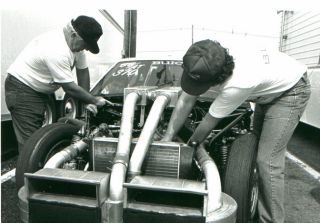
While cubic provided the only power-adder available for Pro Stock, Ingersoll was permitted use of turbochargers as the equalizing factor for the nearly 500 inches he would spot the competition. The mountain motors in 1986 were over 700-inches at the time.
At first, Ingersoll didn’t provide much of a threat. Qualifying in the first few events appeared nothing more than an exercise in futility. In his debut race at the 1986 IHRA Pro-Am Nationals, Ingersoll wasted three engines in qualifying and never cracked the seven zone.
Run by run, Ingersoll worked toward being competitive and finally earned his first qualifying berth by landing in the No. 16 spot during the 1986 Popular Hot Rodding Nationals in Martin, Mi.
The one race that perturbed the tolerant mountain motor racers came one race before his Bristol breakout. Ingersoll not only qualified for this event but concluded qualifying with a 7.16 elapsed time which would have eclipsed Bob Glidden’s 7.216 top qualifying effort by nearly .05. This run came during Saturday’s afternoon session and Ingersoll elected to sit out that evening session after race officials later threw the run out.
The official word for Ingersoll’s disallowed run was a rear-wheel start. Ingersoll adamantly points out the reason given him is the car staged with smoke.
“I was standing there with that old fella that chews tobacco … Charlie Peppers … and he was talking and spitting at the same time and said, “Like hell he staged with the smoke. I run him and he pulled me all the way down the track.”
Little did the competition know that Ingersoll had made a serious engine change in Rockingham which would make all the difference in Bristol two weeks later.
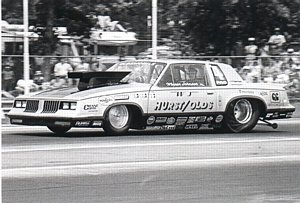
“At Rockingham, I had one turbo on it and everyone thinks when you have more turbochargers on an engine that automatically makes it faster, that’s just not true,” Ingersoll admitted. “The trouble was that I had too much trouble getting it to hook up because I had too much weight on the front spindle. I took the big one off the front and put the two small ones on the car before I went to Bristol. Just having those two back against the firewall made a big difference.”
Ingersoll said the two 204 mm units combined weighed less than the one he used in Rockingham the first go-round.
“I was able to put more weight on the back and immediately, that made it run better,” Ingersoll added.
Ingersoll had run liquid nitrogen previously in his potent V-6, but replaced the combination with a pair of intercoolers from a Buick Grand National.
Ingersoll got beat on a holeshot by Rickie Smith in the first round of Rockingham.
The ex-Warren Johnson Oldsmobile which was re-skinned as a Buick Grand National presented the image of rocket science. Its engine was Indy car technology from McLaren Engines with the blessings and factory support of Buick’s V-6 program. The sleek aerodynamics would make the car a winner from the get-go.
But it wasn’t the aero package that scared everyone. It was the whispering little devil under the flat hood that sent the competition scurrying to race officials demanding the experiment be halted.
Up until Rockingham, there was no basis for their argument.
Bristol opened up the Pandora’s Box of Pro Stock when it came to current Detroit technology.
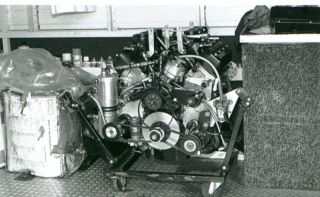
Ingersoll exploited the matter when he drove his way to a 7.374 elapsed time at 191.48 to qualify second behind Glidden.
In four rounds of competition, Ingersoll never ran quicker than the quickest mountain motor car and in fact, his quickest elapsed time, a 7.329 second run was well behind Bob Glidden’s best run of 7.255 seconds. In the final round, his 7.371 elapsed time was no match for Glidden’s superior 7.282.
Many believe it was Ingersoll’s semi-final win over Rickie Smith that punched his time clock in IHRA Pro Stock. Smith left convincingly on Ingersoll only to have the turbo car nip him at the lights.
Smith was none too happy back then and his feelings haven’t changed twenty-two years later. He never liked the idea of more than one combination of power-adders in a professional category.
“It was fixing to be a bad-assed thing if they [IHRA] would have left it alone,” Smith said. “There’s so much unknown knowledge about the turbos out there to this date. The way I look at it, when you run in the professional ranks, everybody should have to run the same thing. If you outrun someone then you are on an equal basis. It’s just like the blowers and nitrous cars of today. You could never really control it unless you’re constantly beating on the guy who picks up. You work night and day on this stuff and someone with a pencil can knock you down. That’s not professional racing in my opinion.”
Ingersoll holds no ill-will towards those who railed against his existence in IHRA Pro Stock citing, “That’s a waste of time worrying about all of that. I try not to even waste brain cells on that stuff. It’s just like the rules when I raced in Competition eliminator, they’d hit my index and I’d just go out there and race without hollering. Not one time did you ever see me bashing anyone in any articles.”
Ingersoll felt that it was Smith who eventually led the campaign to get his car thrown out of the IHRA. This is a charge Smith staunchly denies although he doesn’t deny expressing his opinion on the inclusion of the turbo V-6.
“Bob Glidden came up to me and told me that Rickie was up there at the tower screaming to anyone who would listen and all the Ford people to get me thrown out,” Ingersoll said. “He’s saying you lifted to let me win and doing everything he can to get you thrown out. You need to go up there and defend yourself.”
Ingersoll declined and the next week he was notified by Jones that he could no longer run in IHRA Pro Stock.
“I was told [by then IHRA VP Ted Jones] that Ford was raising hell over me being in there,” Ingersoll recalled. “Ford sponsored a lot in the IHRA and if they [IHRA] couldn’t find another sponsor that I’d have to go. They came back and told me they wouldn’t be able to let me run.”
Jones told CompetitionPlus.com the real argument came from Ingersoll’s fellow competitors.
“Buddy and Buick had a legitimate argument; he had a car that you could buy from Detroit and wondered why he couldn't run it," explained Jones. "He ran well and did very good, but the real problem is that he laid down a few passes that scared the fire out of the V-8 guys. We caught a lot of heat over that. They contended that if he ever got the turbo down pat that they didn't have a prayer. The odd part is that he never won a race."
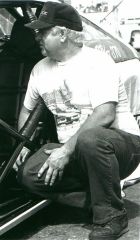
Ingersoll never changed from the easy-going person he was that day and while some might have wondered why Ingersoll never “turned up the wick” against Glidden. He said basic turbo knowledge can answer that question.
“You can’t do that with a turbo car,” Ingersoll admitted. “That’s a big time myth. I left on him and the clutch went out and he drove around me. In all my years of racing, I never had anyone drive around me. With a car like I was running, you have to step up the fuel for the boost and you have to set the timing and everything. That’s a big thing to change and you can't just turn it up without compensating elsewhere or you’ll burn your engine up.”
Ingersoll wouldn't concede that the discontinuation of his combination stunted the growth of Pro Stock, but he was disappointed that it didn't remain part of the program. Looking at today’s Pro Stock, Ingersoll really doesn’t see any incentive for the class, which is based on production vehicles, to step outside of the normal routine and become innovative.
“There’s no real incentive to innovate in either one of the associations when it comes to Pro Stock that I can tell,” Ingersoll admits. “It’s just like this fuel injection issue in the NHRA; they’ve talked about it for ten years and still haven’t done anything. Those cars haven’t changed a bit in forever. The only difference is they only came to a cubic inch limit. The NHRA hasn’t done much either.”
Ingersoll’s long time racing ethic and knowledge of the restraints of a turbo car always mandated the way he raced his Buick. He knew what he was and wasn’t capable of doing.
“I never really had any money in my whole life,” Ingersoll said. “I raced on everything I had and I really couldn’t afford to break anything. I never tried to lean on my stuff really bad. I never really tried to murder anyone like that. If you don’t make it to the finish line, you can’t win a race.
“You can rest assured of one thing,” Ingersoll added. “I didn’t throw any race. I was racing him and if I hadn’t burned up my clutch I would have beat his a**.”

























